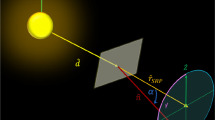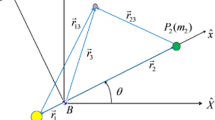Abstract
The aim of this paper is to evaluate the minimum flight time of a solar sail-based spacecraft towards Earth-synchronous (heliocentric) circular displaced orbits. These are special displaced non-Keplerian orbits characterized by a period of one year, which makes them suitable for the observation of Earth’s polar regions. The solar sail is modeled as a flat and purely reflective film with medium-low performance, that is, with a characteristic acceleration less than one millimeter per second squared. Starting from a circular parking orbit of radius equal to one astronomical unit, the optimal steering law is sought by considering the characteristic acceleration that is required for the maintenance of the target Earth-synchronous displaced orbit. The indirect approach used for the calculation of the optimal transfer trajectory allows the minimum flight time to be correlated with several Earth-synchronous displaced orbits, each one being characterized by given values of Earth- spacecraft distance and displacement over the ecliptic. The proposed mathematical model is validated by comparison with results available in the literature, in which a piecewise-constant steering law is used to find the optimal flight time for a transfer towards a one-year Type I non-Keplerian orbit.
Similar content being viewed by others
Change history
11 February 2022
A Correction to this paper has been published: https://doi.org/10.1007/s42064-022-0136-2
References
McKay, R. J., Macdonald, M., Biggs, J., McInnes, C. Survey of highly non-Keplerian orbits with low-thrust propulsion. Journal of Guidance, Control, and Dynamics, 2011, 34(3): 645–666.
McInnes, C. R. Dynamics, stability, and control of displaced non-Keplerian orbits. Journal of Guidance, Control, and Dynamics, 1998, 21(5): 799–805.
Bookless, J., McInnes, C. Dynamics and control of displaced periodic orbits using solar-sail propulsion. Journal of Guidance, Control, and Dynamics, 2006, 29(3): 527–537.
McInnes, C. R. Displaced non-Keplerian orbits using impulsive thrust. Celestial Mechanics and Dynamical Astronomy, 2011, 110(3): 199–215.
Caruso, A., Mengali, G., Quarta, A. A. Elliptic displaced orbit approximation with equally spaced impulses. Journal of Guidance, Control, and Dynamics, 2019, 42(2): 411–415.
Tsuda, Y., Mori, O., Funase, R., Sawada, H., Yamamoto, T., Saiki, T., Endo, T., Kawaguchi, J. Flight status of IKAROS deep space solar sail demonstrator. Acta Astronautica, 2011, 69(9–10): 833–840.
Johnson, L., Whorton, M., Heaton, A., Pinson, R., Laue, G., Adams, C. NanoSail-D: a solar sail demonstration mission. Acta Astronautica, 2011, 68(5-6): 571–575.
Johnson, L., Young, R., Barnes, N., Friedman, L., Lappas, V., McInnes, C. Solar sails: technology and demonstration status. International Journal of Aeronautical and Space Sciences, 2012, 13(4): 421–427.
Johnson, L., Young, R., Montgomery, E., Alhorn, D. Status of solar sail technology within NASA. Advances in Space Research, 2011, 48(11): 1687–1694.
Janhunen, P., Sandroos, A. Simulation study of solar wind push on a charged wire: basis of solar wind electric sail propulsion. Annales Geophysicae, 2007, 25(3): 755–767.
Mengali, G., Quarta, A. A., Janhunen, P. Electric sail performance analysis. Journal of Spacecraft and Rockets, 2008, 45(1): 122–129.
Ceriotti, M., McInnes, C. R., Diedrich, B. L. The pole-sitter mission concept: An overview of recent developments and possible future applications. In: Proceedings of the 62nd International Astronautical Congress, 2011: 2543–2559.
Ceriotti, M., Heiligers, J., McInnes, C. R. Trajectory and spacecraft design for a pole-sitter mission. Journal of Spacecraft and Rockets, 2014, 51(1): 311–326.
Ceriotti, M., McInnes, C. R. Natural and sail-displaced doubly-symmetric Lagrange point orbits for polar coverage. Celestial Mechanics and Dynamical Astronomy, 2012, 114(1-2): 151–180.
Heiligers, J., Parker, J. S., Macdonald, M. Novel solar-sail mission concepts for high-latitude earth and lunar observation. Journal of Guidance, Control, and Dynamics, 2018, 41(1): 212–230.
Ozimek, M. T., Grebow, D. J., Howell, K. C. Design of solar sail trajectories with applications to lunar south pole coverage. Journal of Guidance, Control, and Dynamics, 2009, 32(6): 1884–1897.
Wawrzyniak, G. G., Howell, K. C. Investigating the design space for solar sail trajectories in the earth-moon system. The Open Aerospace Engineering Journal, 2011, 4(1): 26–44.
Heiligers, J., Scheeres, D. J. Solar-sail orbital motion about asteroids and binary asteroid systems. Journal of Guidance, Control, and Dynamics, 2018, 41(9): 1947–1962.
Macdonald, M., McKay, R. J., Vasile, M., De Frescheville, F. B., Biggs, J., McInnes, C. Low-thrustenabled highly-non-Keplerian orbits in support of future Mars exploration. Journal of Guidance, Control, and Dynamics, 2011, 34(5):1396-1411.
West, J. L. The GeoStorm warning mission: enhanced opportunities based on new technology. In: Proceedings of the 14th AAS/AIAA Space Flight Mechanics Conference, 2004: 29–42.
Gong, S. P., Li, J. F. Solar sail heliocentric elliptic displaced orbits. Journal of Guidance, Control, and Dynamics, 2014, 37(6): 2021–2026.
Gong, S. P., Li, J. F. Spin-stabilized solar sail for displaced solar orbits. Aerospace Science and Technology, 2014, 32(1): 188–199.
Song, M., He, X. S., He, D. S. Displaced orbits for solar sail equipped with reflectance control devices in Hill’s restricted three-body problem with oblateness. Astrophysics and Space Science, 2016, 361(10): 327.
Mengali, G., Quarta, A. A. Non-Keplerian orbits for electric sails. Celestial Mechanics and Dynamical Astronomy, 2009, 105(1–3): 179–195.
Niccolai, L., Quarta, A. A., Mengali, G. Electric sail-based displaced orbits with a refined thrust model. Proceedings of the Institution of Mechanical Engineers, Part G: Journal of Aerospace Engineering, 2018, 232(3): 423–432.
Niccolai, L., Quarta, A. A., Mengali, G. Electric sail elliptic displaced orbits with advanced thrust model. Acta Astronautica, 2017, 138: 503–511.
Powers, R. B., Coverstone, V. L. Optimal solar sail orbit transfers to synchronous orbits. Journal of the Astronautical Sciences, 2001, 49(2): 269–281.
Hughes, G. W., McInnes, C. R. Solar sail hybrid trajectory optimization for non-Keplerian orbit transfers. Journal of Guidance, Control, and Dynamics, 2002, 25(3): 602–604.
Mengali, G., Quarta, A. A. Solar sail trajectories with piecewise-constant steering laws. Aerospace Science and Technology, 2009, 13(8): 431–441.
Wright, J. L. Space Sailing. Philadelphia: Gordon and Breach Science Publishers, 1992: 223.
Dachwald, B., Macdonald, M., McInnes, C. R., Mengali, G., Quarta, A. A. Impact of optical degradation on solar sail mission performance. Journal of Spacecraft and Rockets, 2007, 44(4): 740–749.
McInnes, C. R. Solar Sailing: Technology, Dynamics and Mission Applications. London: Springer-Verlag Berlin Heidelberg, 1999: 46–51.
Wie, B. Thrust vector control analysis and design for solar-sail spacecraft. Journal of Spacecraft and Rockets, 2007, 44(3): 545–557.
Aliasi, G., Mengali, G., Quarta, A. A. Artificial Lagrange points for solar sail with electrochromic material panels. Journal of Guidance, Control, and Dynamics, 2013, 36(5): 1544–1550.
Mengali, G., Quarta, A. A. Heliocentric trajectory analysis of sun-pointing smart dust with electrochromic control. Advances in Space Research, 2016, 57(4): 991–1001.
Ceriotti, M., Harkness, P., McRobb, M. Variable-geometry solar sailing: the possibilities of the quasirhombic Pyramid. In: Advances in Solar Sailing. Macdonlald M., Ed. Berlin, Heidelberg: Spring-Verlag Berlin Heidelberg, 2014: 899–919.
Heiligers, J., Guerrant, D., Lawrence, D. Exploring the Heliogyro’s orbital control capabilities for solar sail halo orbits. Journal of Guidance, Control, and Dynamics, 2017, 40(10): 2569–2586.
Stengel, R. F. Optimal Control and Estimation. New York: Dover Publications. 1994: 222–254.
Sauer, C. G. Jr. Optimum solar-sail interplanetary trajectories. In: Proceedings of the Astrodynamics Conference, 1976: 792.
Lawden, D. F. Optimal Trajectories for Space Navigation. London: Butterworths. 1963: 54–60.
Mengali, G., Quarta, A. A. Optimal three-dimensional interplanetary rendezvous using non-ideal solar sail. Journal of Guidance, Control, and Dynamics, 2005, 28(1): 173–177.
Niccolai, L., Quarta, A. A., Mengali, G. Analytical solution of the optimal steering law for non-ideal solar sail. Aerospace Science and Technology, 2017, 62: 11–18.
Bryson, A. E., Ho, Y. C. Applied Optimal Control. Washington, D. C: Hemisphere Publishing Corporation. 1975: 71–89.
Shampine, L. F., Reichelt, M. W. The MATLAB ODE suite. SIAM Journal on Scientific Computing, 1997, 18(1): 1–22.
Acknowledgements
This work is supported by the University of Pisa, Progetti di Ricerca di Ateneo (Grant No. PRA_2018_44).
Author information
Authors and Affiliations
Corresponding author
Additional information
Alessandro A. Quarta received his Ph.D. degree in aerospace engineering from the University of Pisa in 2005, and is currently a professor of flight mechanics at the Department of Civil and Industrial Engineering of the University of Pisa. His main research areas include spaceflight simulation, spacecraft mission analysis and design, low-thrust trajectory optimization, solar sail and E-sail dynamics and control.
Giovanni Mengali received his doctor degree in aeronautical engineering in 1989 from the University of Pisa. Since 1990, he has been with the Department of Aerospace Engineering (now Department of Civil and Industrial Engineering) of the University of Pisa, first as a Ph.D. student, then as an assistant and an associate professor. Currently, he is a professor of space flight mechanics. His main research areas include spacecraft mission analysis, trajectory optimization, solar sails, electric sails and aircraft flight dynamics and control.
Marco Bassetto graduated in aerospace engineering in 2016. Since 2016, he is a Ph.D. student at the Department of Civil and Industrial Engineering of the University of Pisa. His research activities mainly focus on mission design and trajectory analysis of spacecraft propelled with low-thrust propulsion systems, such as solar sails and electric solar wind sails.
Rights and permissions
About this article
Cite this article
Quarta, A.A., Mengali, G. & Bassetto, M. Optimal solar sail transfers to circular Earth-synchronous displaced orbits. Astrodyn 4, 193–204 (2020). https://doi.org/10.1007/s42064-019-0057-x
Received:
Accepted:
Published:
Issue Date:
DOI: https://doi.org/10.1007/s42064-019-0057-x




